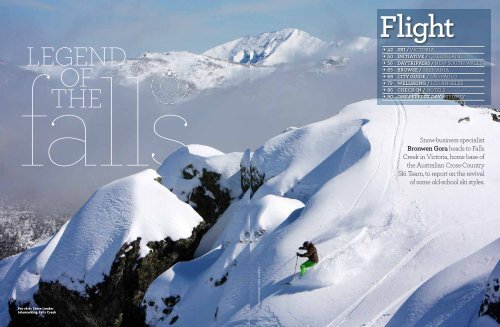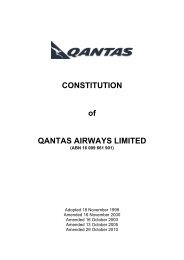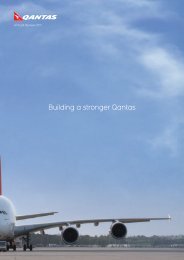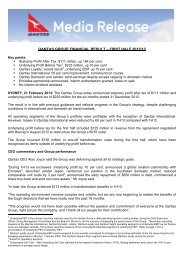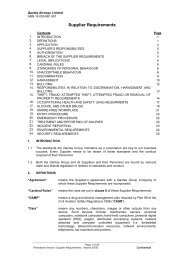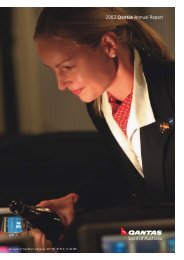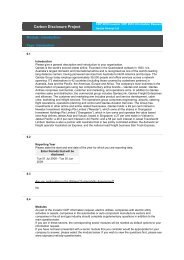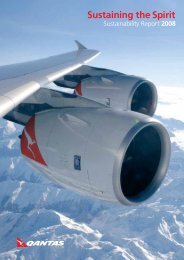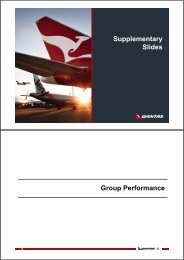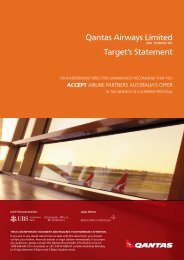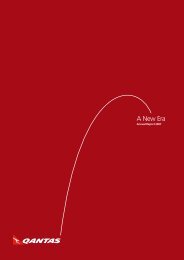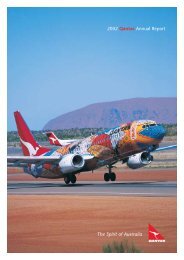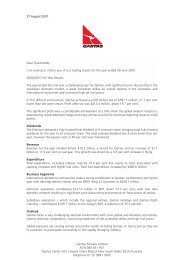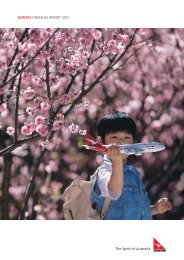Falls Creek - The Australian Way - August 2012 - Qantas
Falls Creek - The Australian Way - August 2012 - Qantas
Falls Creek - The Australian Way - August 2012 - Qantas
You also want an ePaper? Increase the reach of your titles
YUMPU automatically turns print PDFs into web optimized ePapers that Google loves.
Flight<br />
legend<br />
falls<br />
of<br />
the<br />
✈ 42 ski / victoria<br />
✈ 50 initiative / queensland<br />
✈ 56 daytrippers / new south wales<br />
✈ 65 browse / tasmania<br />
✈ 68 city guide / sÃo paulo<br />
✈ 79 wellbeing / los angeles<br />
✈ 86 check-in / hotels<br />
✈ 90 one perfect day / sydney<br />
Snow-business specialist<br />
Bronwen Gora heads to <strong>Falls</strong><br />
<strong>Creek</strong> in Victoria, home base of<br />
the <strong>Australian</strong> Cross-Country<br />
Ski Team, to report on the revival<br />
of some old-school ski styles.<br />
Pro skier Steve Leeder<br />
telemarking, <strong>Falls</strong> <strong>Creek</strong><br />
photography: chris hocking
In skiing, everything old is new again. Enter crosscountry<br />
skiing, telemark and skate skiing. All three<br />
styles – which differ from downhill skiing in that<br />
the heel is free from the binding, with only the front<br />
of the boot attached – are enjoying a resurgence<br />
worldwide. Driving the revival is a desire among<br />
skiers to escape the bustle of commercial resorts in<br />
favour of traversing the mountains under their own<br />
steam, and to achieve a higher level of fitness than<br />
that afforded by regular downhill skiing.<br />
Cross-country skiers use long, skinny skis and<br />
poles to propel them in a smooth, gliding motion<br />
across generally flat terrain outside ski resorts,<br />
usually valley floors or high plains. This form of<br />
skiing can be traced back to the Stone Age – wooden<br />
skis have been discovered in Russia dating to<br />
6300BC. <strong>The</strong> theory is that as prehistoric man<br />
moved north, he encountered snow and was forced<br />
to develop a way to move across it in order to hunt.<br />
Telemark skiing, where the heel is free but a strap<br />
around the back of the boot stabilises it, is the<br />
downhill form. Sondre Norheim is credited with<br />
throwing the first telemark turn in 1868, during a<br />
Norwegian national skiing competition. He carved<br />
the long, fluid turn after landing by sliding one ski<br />
in front of the other, dropping the back knee and<br />
then lunging forward with the front leg.<br />
Skate skiing – think ice-skating or rollerblading<br />
on skis – emerged in its current form when an<br />
American Olympic silver medallist, Bill Koch,<br />
deployed an unusual technique in a 1982 World<br />
Cup competition. By pushing his cross-country skis<br />
out to each side like an ice-skater, he was able to go<br />
faster than the competition and was named FIS<br />
(Fédération Internationale de Ski) Cross-Country<br />
World Cup champion 1981-82.<br />
As home to Australia’s National Cross-Country<br />
Ski Team, <strong>Falls</strong> <strong>Creek</strong> is among the best places in<br />
the country to learn these styles. <strong>The</strong> resort has a<br />
large network of world-class cross-country ski trails<br />
and every part of its 65sq km is free to access at <br />
Big air at<br />
<strong>Falls</strong> <strong>Creek</strong><br />
photography: chris hocking<br />
44 QANTAS august <strong>2012</strong>
Clockwise from above:<br />
executing a telemark turn;<br />
skate-skiing pioneer Bill<br />
Koch; cross-country skiers<br />
any time. <strong>The</strong> setting is particularly beautiful. <strong>Falls</strong> <strong>Creek</strong> nestles in<br />
the thickly wooded hills of the Kiewa Valley, its ski trails flanked by<br />
snow gums. Because <strong>Falls</strong> <strong>Creek</strong> is a ski field more geared towards<br />
novice than challenging slopes, it is well suited to learners of all styles.<br />
Cross-country practice<br />
Downhill skiers might think their chosen sport is an excellent<br />
workout, but compared to other styles, it’s a doddle. Thanks to the<br />
luxury of ski lifts and well-groomed runs, gliding around on even the<br />
steepest pitch is a relative breeze.<br />
Not so with cross-country skiing. Participants are guaranteed to<br />
boost their fitness substantially as this style requires more physical<br />
action for forward propulsion. At <strong>Falls</strong> <strong>Creek</strong>, cross-country tracks<br />
are groomed, enabling skiers to glide along in the grooves. Even so,<br />
it can be physically punishing. In terms of technique, the key points<br />
are to relax the knees, keep the hips forward and not fight the skis.<br />
<strong>The</strong> objective is to create a steady rhythm of striding and poling.<br />
“Poling is very important because you’re using your arms as part<br />
of the perpetual movement of the technique,” says Mark Weir,<br />
manager of the YMCA Howmans Gap Alpine Centre, which operates<br />
the <strong>Falls</strong> <strong>Creek</strong> Nordic Centre. “Realistically, to go out and have some<br />
fun, it would take half an hour to pick up cross-country skiing.”<br />
Still, first attempts at gliding on cross-country skis require serious<br />
concentration. For starters, the boots are more like trainers, providing<br />
far less stability than even a regular ski boot. Consequently, it is<br />
easy for the skis to slip underneath and place a learner firmly on their<br />
rear end, or on their side, in seconds. But once settled into a rhythmic,<br />
walking-while-gliding movement, assisted by poles far longer than<br />
those used in downhill skiing, the hard part is over. Group lessons at<br />
<strong>Falls</strong> <strong>Creek</strong> Nordic Centre (25 Bogong High Plains Road, 03 5758<br />
3408) are $46 for 90 minutes; private lessons $92 an hour.<br />
Telemark, set, go<br />
Telemark is the perfect complement to downhill skiing. It strengthens<br />
thigh, gluteal and core muscles, and improves balance. Learners are<br />
presented with new challenges at every turn. First attempts to master<br />
the graceful, fluid technique – in which one ski slides in front of the<br />
other to create the deep lunging turn – are generally accompanied<br />
by much wobbling and hesitation.<br />
Compared to downhill equipment, telemark skis are lighter and<br />
skinnier, and the boots are nowhere near as stiff. Most importantly,<br />
the heel is not attached to the ski in order to allow the hallmark turn<br />
to be executed. This also allows a skier to attach climbing “skins” for<br />
ski touring in the backcountry. Skins are synthetic strips that stick<br />
to the bottom of the ski when a telemark skier wants to walk. <strong>The</strong>y<br />
are covered with hairs that grip the snow, allowing them to slide the<br />
skis forward and glide along, even uphill, without sliding backwards.<br />
Once atop the mountain, they are detached, rolled up and stuck in a<br />
backpack for the descent.<br />
For those used to downhill skiing, gliding down the slope for the<br />
first time on telemark equipment will feel highly unstable. But the<br />
skills developed for downhill skiing are a big help in understanding<br />
the technique behind telemark’s classic turn. “<strong>The</strong> first thing students<br />
become very conscious of is where they are standing on the ski,” <br />
telemark photography: chris hocking; cross-country: aap image; bill koch: corbis australia<br />
46 QANTAS august <strong>2012</strong>
ski victoria<br />
Clockwise: Quay<br />
West balcony;<br />
Huski suite; Mark<br />
LaBrooy (left) &<br />
Jeff Bennett of<br />
Three Blue Ducks<br />
For airfares call<br />
<strong>Qantas</strong> on 13 13 13 or visit<br />
qantas.com. For holiday<br />
packages to <strong>Falls</strong> <strong>Creek</strong> call<br />
<strong>Qantas</strong> Holidays on 13 14 15.<br />
says <strong>Falls</strong> <strong>Creek</strong> Snowsports School director Francis Jackson. “<strong>The</strong>re<br />
are none of the luxuries such as stiff boots that they have had with<br />
[normal] ski equipment to help them overcome their shortcomings.”<br />
But diligent effort pays off. Within a day, most experienced skiers<br />
will be able to master a few satisfying turns and experience the<br />
signature fluidity. “With modern equipment, telemark is just as easy<br />
to learn as downhill – and possibly more enjoyable,” says Jackson.<br />
<strong>Falls</strong> <strong>Creek</strong> Snowsports School (03 5758 1000, www.fallscreek.com.<br />
au/snowsports) offers private lessons from $106 per hour.<br />
Get your skates on<br />
Of the three styles, skate skiing requires the highest levels of fitness<br />
and strength as the skier moves forward by pushing from side to side<br />
like an ice-skater, instead of simply gliding forward as in crosscountry.<br />
It also calls for the most patience, as the skis are narrower<br />
and shorter than those used in cross-country skiing. Indeed, the first<br />
time on skate skis feels like balancing on a pair of chopsticks. And<br />
despite being stiffer than cross-country boots, the footwear feels far<br />
flimsier than the downhill kind.<br />
Crucially, skate skis cannot be used in a simple forward motion.<br />
Thanks to their knife-like structure (compared to other skis) and lack<br />
of metal edges, they need to be used like a pair of rollerblades or iceskates.<br />
<strong>The</strong> poles are longer again than those used in cross-country<br />
and feel even more unwieldy at first. “Longer poles are needed<br />
because a skier really has to throw themselves forward,” says Weir.<br />
Because skate skiing is quite technical, lessons are recommended,<br />
but the rewards are substantial. “It’s the most aerobic of all the styles,”<br />
says Weir. “Skate skiers are some of the fittest people in the world.”<br />
And exhilaration is a large part of the payoff. “It’s a fantastic way to<br />
be out in the mountains, during the day or under a full moon.”<br />
Eat & stay<br />
As befits an area that’s home to such physically demanding forms of<br />
skiing, <strong>Falls</strong> <strong>Creek</strong> has some of the best restaurants and lodgings in<br />
the Victorian Alps. New this season is Three Blue Ducks (3 Sitzmark<br />
Street, 1300 652 260, www.huski.com.au). Located in the Huski<br />
apartment complex, it’s run by a team that includes former Tetsuya<br />
chefs Darren Robertson and Mark LaBrooy. <strong>The</strong>ir alpine eatery is<br />
named after its renowned Sydney counterpart in Bronte. Summit<br />
Ridge (8 Schuss Street, 03 5758 3800) is another excellent choice, not<br />
only for its focus on local produce, but for its 240-strong wine list.<br />
Huski features studios, apartments and a penthouse. Studios start<br />
at $432 a night for seven nights. Quay West Resort & Spa (17 Bogong<br />
High Plains Road, 03 5732 8000, mirvachotels.com) is suitably luxurious<br />
and has rooms from $688 (minimum two-night stay). One of its<br />
biggest drawcards is the apartment balconies, which have been fitted<br />
with private hot tubs that take full advantage of the uninterrupted<br />
mountain views. Three-bedroom apartments at Alpine Woodsmoke<br />
(216 Bogong High Plains Road, 03 5758 3182, woodsmoke.com.au)<br />
are $1465 a night (minimum two-nights). <br />
c<br />
quay west photography hamilton lund; huski charlie brown; three blue ducks: peter bennetts<br />
48 QANTAS august <strong>2012</strong>


